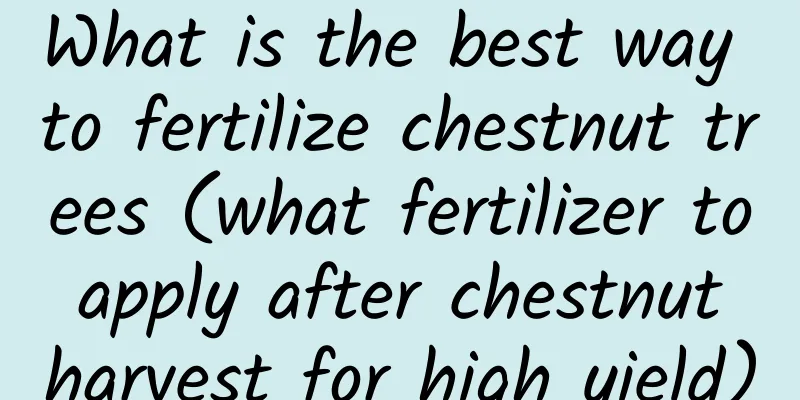What is the best way to fertilize chestnut trees (what fertilizer to apply after chestnut harvest for high yield)

|
Chestnut is a fruit tree native to my country with a long history of cultivation, many varieties, and a very wide cultivation area. Chestnuts grow very fast and are relatively easy to manage. They have strong adaptability and are resistant to drought and flooding. They can be planted almost anywhere, whether it is barren hills or thin land, or riverbanks or plains. They also have relatively high and stable yields and a long lifespan. Planting them once will bring benefits for a hundred years. Of course, all of this can only be achieved under the premise of reasonable water and fertilizer management, reasonable pruning, and good disease and pest control. How should chestnuts be fertilized? 1. Fertilization period and types of chestnutsChestnuts need organic fertilizers, nitrogen, phosphorus, potassium, and trace elements such as manganese, iron, magnesium, and boron to grow. This can reduce fruit drop, increase fruit set, achieve the goal of increasing production, and also improve drought resistance and early maturity. According to the growth and fruiting characteristics of chestnuts, we need to seize three key periods to apply fertilizer : 1. Spring germination periodDuring the development period of female flowers after chestnuts germinate in spring, we should apply nitrogen fertilizer to promote the differentiation of female flower buds, increase the number of female flowers, and promote the vigorous growth of branches and leaves, which is an important basis for increasing the chestnut yield that year. 2. Young fruit growth periodThe young fruit growth period of chestnut is a critical period for fruit development and increase in flesh weight. At this time, applying nitrogen, phosphorus and potassium fertilizers can promote the increase of chestnut grains and plump flesh, laying a solid foundation for increasing yield. 3. Autumn harvest periodIn autumn, chestnuts enter the fruit ripening period. After harvesting the fruits, we can apply more organic fertilizers, such as manure, compost and other organic fertilizers, in combination with deep plowing. The purpose is to restore the tree vigor, promote the differentiation of flower buds, and lay the foundation for a bumper harvest next year. This is the type and period of topdressing required for chestnuts, and it is also the critical period. The following is a detailed description of how to topdress in spring. 2. Fertilization of chestnuts in spring1. Planting periodChestnuts can be planted before spring budding. When planting, dig a large hole, mix the decomposed organic fertilizer and mature soil thoroughly, and then backfill the hole. Plant the chestnut saplings straight, with the roots stretched out, fill the soil and tamp it down, and lift the saplings slightly after half of the soil is buried, so that the roots can stretch out further. The planting depth should maintain the original soil depth, and after planting, tamp it down and water it to increase the survival rate. 2. Spring topdressing for seedling slowingBefore chestnuts sprout in spring, you can apply nitrogen fertilizers such as urea and ammonium bicarbonate to promote the development of flowers, and water after fertilizing. When the leaves at the base of the chestnut branches just unfold and turn from yellow to green, foliar fertilizer can be applied, such as a mixture of urea + potassium dihydrogen phosphate + borax, and gibberellin can be sprayed during the growth period of new shoots to promote the development and formation of female flowers. Apply nitrogen, phosphorus and potassium compound fertilizer before flowering, and water after applying fertilizer . Annual dwarf crops or green manure can also be sown between the rows to improve the soil and enhance the soil fertility. 3. Topdressing in other periodsFrom late July to early August, chestnuts enter a period of rapid expansion and weight gain. It is necessary to apply nitrogen, phosphorus and potassium compound fertilizer, and water them with heavy water according to the soil moisture content. At this time, orchards that grow green manure can turn the soil and press green manure or cover the ground or tree trays after mowing. Half a month or one month before harvest, potassium dihydrogen phosphate can be sprayed 1-2 times at intervals of 10-15 days to improve the photosynthesis of the leaves, which can increase weight and improve quality. After harvesting chestnuts, spray urea solution on the leaves, and in October you can apply base fertilizer, which is decomposed organic fertilizer. For orchards with serious empty buds, boron fertilizer should be applied. The method is to dig a hole with a depth of one shovel and a width of one shovel every 2-3 meters along the outer periphery of the chestnut crown. Then, we sprinkle borax into the pit, fill it with organic fertilizer, and then water it to dissolve the borax. You can also dissolve borax in water, pour borax water into the hole after digging, apply organic fertilizer and cover it with soil. 【 Summarize 】 As for how much fertilizer should be applied per acre of chestnuts, it varies depending on the region, tree vigor, variety, cultivation conditions, etc. There is no uniform quantity standard. Just decide based on your own situation. At present, chestnuts are mainly fertilized by root application and foliar application. Root fertilization mainly uses basal fertilizer and quick-acting fertilizer, while foliar fertilization mainly uses trace element fertilizer and quick-acting fertilizer. Foliar fertilization is an effective fertilization method to improve chestnut yield and quality . |
Recommend
Put jasmine into the pot and boil it, the leaves will be green, the branches will be strong, and the flowers will bloom!
Flower soil into the pot Use an abandoned iron ba...
How to eat Custard Apple and how to tell if it is ripe
1. How to eat 1. Eat raw: After it is fully ripe,...
How to grow Guanyin bamboo and what to pay attention to
Growth habits of Guanyin bamboo Guanyin bamboo li...
Does Ji Xiaoju prefer shade or sun?
Does Ji Xiaoju prefer shade or sun? Chrysanthemum...
Every household has this thing. Throw it in a pot and the flowers will grow quickly, and the pot will be full of flowers in one summer!
Glass beads When I was a kid, I played checkers. ...
How to prune lilies?
Lily pruning time Lilies can be pruned twice a ye...
Is Impatiens fasciata poisonous?
Is Impatiens fasciata poisonous? To be honest, ma...
How and when to plant peony
Peony planting time 1. Planting Peonies in Spring...
How to plant golden thread vine (introduction to planting methods)
1. Seed planting method 1. Choose good seeds: Whe...
Can orchids be exposed to the sun? Can they be exposed to the sun in summer?
Can orchids be exposed to the sun? Orchids can ba...
When is the best season to plant golden camellia? When and how to plant golden camellia?
It is best to choose loose, fertile, well-drained...
Is it profitable to grow grapefruit? How much profit can one acre of grapefruit make?
Is growing grapefruit profitable? Pomelo is a com...
What to do if potted pomegranate flowers lose leaves in winter
1. Not moving indoors in time Although pomegranat...
How to prune Chlorophytum comosum
How to prune the branches of Chlorophytum comosum...
What are the cultivation methods and precautions of red diamond flowers?
Introduction of Red Diamond Flower The red diamon...









